With research showing that professional drivers are twice as likely to develop type 2 diabetes than the general public, a new report sets out proven, low-cost measures fleet managers can adopt to both protect driver health and reduce the risk of road accidents involving drivers affected by symptoms of the condition.
Features
Hiding in plain sight: diabetes in the road transport sector
More than 300,000 HGV drivers operate across the UK transport network. Yet, a recent report reveals a silent but growing safety threat: type 2 diabetes. Hiding in Plain Sight: The UK Diabetes Crisis – A Call to Action to the Road Transport Sector – collaboratively authored by the Diabetes Safety Organisation, the Parliamentary Advisory Council for Transport Safety (PACTS) and Driving for Better Business (DfBB) – highlights how this largely invisible health condition impairs concentration, reaction times and overall safety.
A sector at risk
The report reveals that:
- 1 in 3 adults with type 2 diabetes are undiagnosed, many holding safety-critical driving roles.
- Professional drivers are twice as likely to develop diabetes.
- The issue remains unrecorded within collision and incident data, leaving a dangerous blind spot in risk management.
- Employers may be in breach of their health and safety obligations if they fail to assess and mitigate diabetes-related risks and support employees with diabetes – health and safety and equality law puts a duty of care on employers to provide support.
- Proven, low-cost interventions are available to create ‘diabetes safe’ workplaces.
Why diabetes matters for road safety
The human factors impact
Type 2 diabetes contributes to several impairments:
- Hypoglycaemia (hypos): low blood sugar can trigger confusion, fainting and unconsciousness.
- Hyperglycaemia: high blood sugar causes fatigue, blurred vision and reduced alertness.
- Neuropathy: nerve damage in feet leads to poor pedal control, increasing crash risk.
- Complications: eye issues (retinopathy) reduce visual acuity, while heart complications affect endurance and concentration.
 1 in 3 adults with type 2 diabetes are undiagnosed, many holding safety-critical driving roles. Photograph: iStock
1 in 3 adults with type 2 diabetes are undiagnosed, many holding safety-critical driving roles. Photograph: iStock
The Driver and Vehicle Licensing Agency (DVLA) has requirements for drivers using certain diabetes treatments to keep their blood sugar above 5mmol/L before driving and to stop and monitor their levels every two hours. There are strict requirements for testing and treating when driving with diabetes. The DVLA assesses every case individually so every driver with diabetes should check the DVLA requirements.
However, it has been estimated that 40 per cent of drivers with insulin-treatable diabetes have not declared their condition to the DVLA. This is a legal requirement that can invalidate insurance as well as increase driving safety risk.
Workforce and economic impacts
The transport sector is already challenged by high levels of absence and staff shortages. Diabetes intensifies this crisis:
- 38 per cent of workers living with diabetes aged 45–64 leave the workforce early due to complications – some citing heart disease, a diabetes-linked condition.
- Employers risk liability under health and safety and equality laws if they fail to address diabetes as a workplace risk. The report emphasises that simple, reasonable safeguards can avert significant long-term costs and operational disruptions.
Hard evidence and case studies
No data, no problem?
Currently, collision reports, DVSA/ DVLA health checks and fleet records do not identify diabetes as a contributing factor. Nor does the medical assessment demanded at age 45 adequately address it – screening is voluntary, often delayed, and fails to cover privately driven vehicles.
Jamie Hassall, executive director, PACTS, says: “Too many drivers are leaving the workforce early due to ill health and helping them manage their diabetes is good for business and road safety. Diabetes is not just a public health issue – it’s a workplace safety risk. If left undiagnosed and unmanaged, type 2 diabetes can lead to catastrophic outcomes behind the wheel.”
He added: “It’s clear from the evidence that companies aren’t managing the health of their drivers and so they are at greater risk of being affected by diabetes. The impact is not just on road safety, but also wider health and productivity, with many of these drivers leaving the workforce early due to ill health.
“The benefits of helping staff managing their health are likely to far outweigh any costs in doing this.”
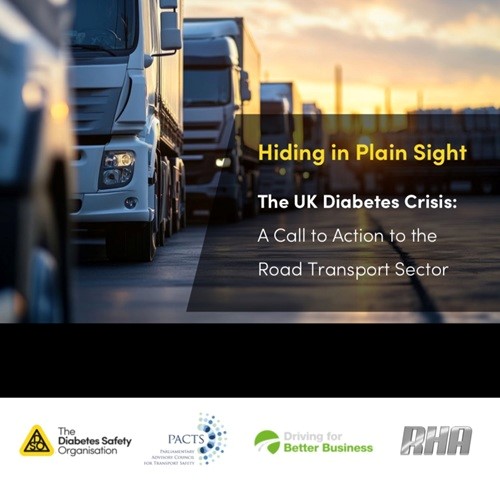 Hiding in Plain Sight, a new report, invites the road transport sector to face a widespread, correctable risk.
Hiding in Plain Sight, a new report, invites the road transport sector to face a widespread, correctable risk.
Employer size = variable capability
Although larger employers often have resources to implement health screening, smaller firms may lack capacity or awareness. Yet, both are motivated by:
- Driver retention
- Insurance costs
- Fleet credentials in tender processes.
Supply-chain audits and fleet accreditation (for example, FORS (Fleet Operator Recognition Scheme) and RHA (Road Haulage Association)), are potential levers for driving sector-wide change.
Organisations driving change
With over 40 years advising both Houses of Parliament on transport safety, PACTS is a charity with a vision for a transport system free from death and life changing injury where all users feel safe.
Driving for Better Business (DFBB) is a National Highways programme to help employers reduce work-related road risk, control the associated costs and improve compliance with current legislation and guidance.
Simon Turner, DfBB engagement manager, says: “A healthy driver is a safer driver. This report gives every everyone involved in managing driver safety a blueprint for understanding this key emerging risk and acting quickly to improve awareness within the organisation. Driving for Better Business is already integrating diabetes information into the articles, resources and toolkits that are freely available from our website.”
The Diabetes Safety Organisation (DSO) was established to address the ever-present and increasing safety risk posed by diabetes. It helps organisations to recognise the invisible risk that is currently not being addressed, that leaves employees exposed to a potential fatality and companies open to criminal liability.
Founder and managing director, Kate Walker says: “This is a silent threat to the health of our transport workforce and the safety of everyone on the road. We are calling on employers, regulators and politicians to step up now.”
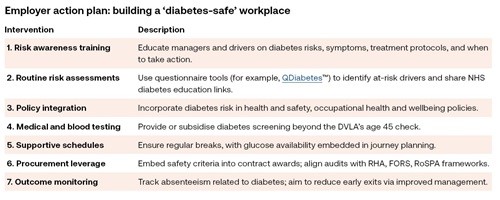
The seven key steps outlined in the table above, while straightforward and low-cost, could yield high returns in safety, workforce stability and reduced insurance exposure.
Voices from the industry
The report features testimonials from a diverse sector range:
- “[Diabetes] significantly impairs concentration, reaction times and long-term wellbeing” – Evri, multi-modal logistics operator
- “A major, under‑recognised health and safety crisis” – Evri, RHA and FORS endorsing the report.
This alignment across sector stakeholders amplifies the report’s urgency and practical utility.
Regulatory gaps and legal duty
Existing DVLA regulations only require medicals once a driver reaches 45 – and focus mainly on hypoglycaemia risk, meaning diabetic peripheral neuropathy and other complications can go unchecked.
Legal obligations under the Health and Safety at Work Act and the Equality Act arguably oblige employers to proactively manage diabetes risk – not simply defer to regulatory-minimal compliance.
Case spotlight: RHA and FORS leadership
The Road Haulage Association (RHA), representing thousands of transport businesses, has formally supported the report. Its members are now reviewing screening guidance and integrating diabetes into best-practice guidelines.
FORS (Fleet Operator Recognition Scheme) is updating its accreditation requirements –encouraging operators to demonstrate proactive health screening, including for diabetes.
This signals commitment from major gatekeepers in service auctions and regulated tendering processes.
How to get started: a practical roadmap
- Download the report and executive summary: available from the Diabetes Safety Organisation website. Also, see DSO’s Diabetes Safe Driving – Driver Guide.
Initiate internal awareness: host team briefings and toolbox talks using free slide decks from DfBB. - Perform risk assessments: DSO provides an organisational risk assessment tool which focuses on health and safety policies and procedures to manage diabetes risk. It assesses results and provides recommendations. Companies that put various reasonable checks and balances in place can become accredited as Diabetes Safe organisations.
- Pilot screenings: use mobile clinics or partner with local health providers for simple tests.
- Log outcomes: record diagnoses/disclosures, interventions and absentee trends.
- Share results: benchmark internally and, if possible, engage suppliers to scale impact.
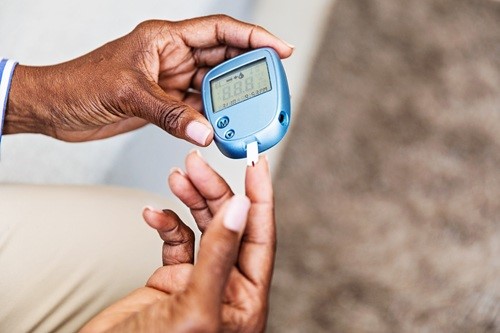 If left undiagnosed and unmanaged, type 2 diabetes can lead to catastrophic outcomes behind the wheel. Photograph: iStock
If left undiagnosed and unmanaged, type 2 diabetes can lead to catastrophic outcomes behind the wheel. Photograph: iStock
Safe drivers, safer roads: the business case
Integrated diabetes risk management delivers:
- Elevated safety outcomes through early intervention
- Lower absence and staff turnover
- Enhanced insurance and operational resilience
- Stronger tender competitiveness with healthier credentials
- Improved corporate reputation and ESG positioning.
- In a sector defined by narrow margins and regulatory scrutiny, proactive driver safety interventions are both ethical and commercially imperative.
Real stories and testimony
- Commercial Motor reported that industry leaders across logistics, parcel delivery and public transport are engaging with the report
- OSH Forum emphasised diabetes as a “major, under-recognised” risk and called for cross-government and sector action.
Leading employers quoted in the report include Evri, RHA, FORS and major fleets, reinforcing its applicability across segments.
What does this mean, and where next?
Regulatory review is now warranted, including:
- Expanding DVLA medical requirements
- Including privately-owned vehicles in assessments
- Mandating organisational risk screening
- Positioning diabetes as an occupational disease
- Enhancing cross-departmental action between transport and health bodies.
For employers already mandated to meet heath and safety requirements, diabetes – treated like working hours, vehicle checks or mental health support – demands equal rigour.
Conclusion: a call to action
Hiding in Plain Sight invites the road transport sector to face a widespread, correctable risk. Diabetes is preventable, screenable and manageable. Yet its absence from current safety frameworks is a systemic failure.
Australia, Canada and parts of the US are now trialling occupational diabetes initiatives with truck fleets; and the UK is therefore positioned to lead. For transport operators, fleet managers, safety leads and health and safety professionals, the report offers a clear, actionable blueprint.
Getting involved
- Download the full report, plus executive summary, of Hiding in Plain Sight: The UK Diabetes Crisis – A Call to Action to the Road Transport Sector
- Survey your staff anonymously to find out your hidden risks: contact the DSO for an independent, free survey and report
- Register with DfBB for toolkits and training
- Engage with PACTS or join its stakeholder network
- Incorporate diabetes risk into internal health and road safety policies
- Pilot annual or biannual diabetes screening and monitor outcomes
- Contact DSO for a free risk assessment to move towards Diabetes Safe Accreditation.
By doing so, the transport sector can protect its workforce, secure supply chains and uphold its core mission: delivering safely, reliably, and responsibly.
For more details, and to access sector-specific resorts, visit:
www.drivingforbetterbusiness.com
Becky Hadley is a PR writing on behalf of the above-named organisations
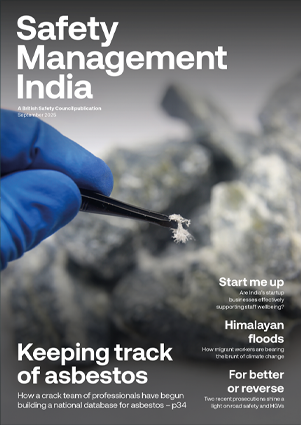
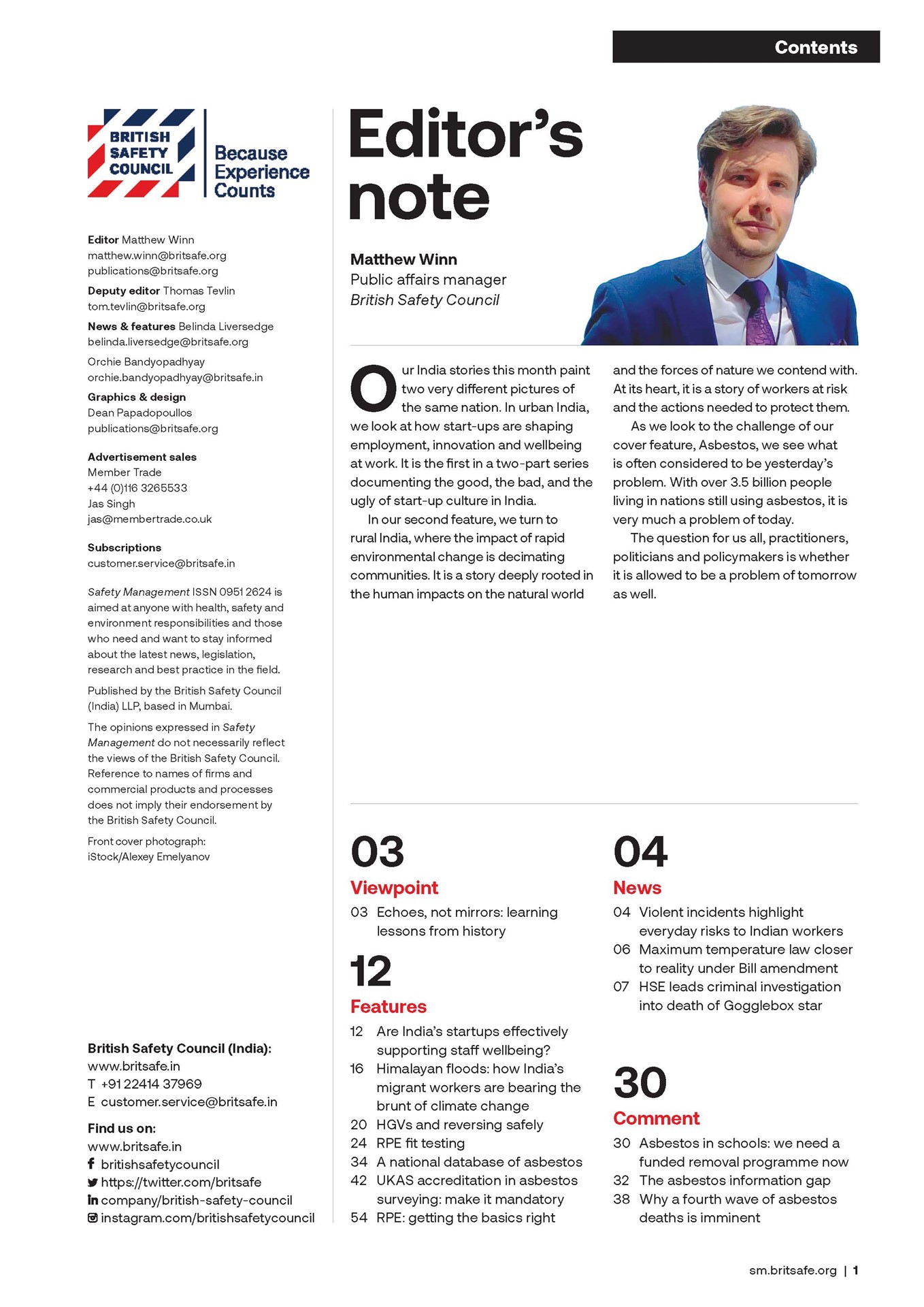
FEATURES

Delhi’s air pollution problem leaves construction workers jobless and without pay
By Orchie Bandyopadhyay on 10 November 2025
Every autumn and winter, Delhi experiences terrible air pollution that places the health of its 40 million residents at grave risk. But government measures to alleviate the problem by temporarily closing construction sites mean hundreds of thousands of daily-wage labourers are being left without wages and a means of financial support.

India’s road rage crisis: how professional drivers are bearing the brunt
By Orchie Bandyopadhyay on 10 November 2025
High profile reports of violent attacks on people who drive for work purposes, like bus and delivery drivers, have shone a spotlight on the growing problem of road rage in India. Commentators say it is now time for the Government to step up prosecutions of those who act aggressively on the road, while educating drivers on stress management techniques, to tackle the problem.

